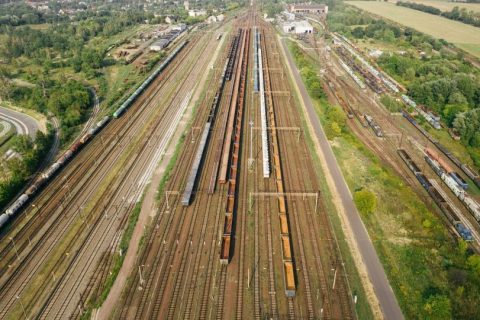Coming to terms with the diverse infrastructure of Poland and Ukraine
10 March 2023
“We have to come to terms with the diversity of infrastructure and rolling stock between Poland and Ukraine and seek ways of neutralising the obstacle it creates”. This was said by Tadeusz Syryjczyk, partner of the Transport Consultants Group (TOR) in a report the Polish consultancy firm wrote about Polish – Ukrainian railway relations – Current status, potential, challenges.
The report, which was published in fall last year, will be presented at the RailFreight Summit Poland by Michal Grobelny, project manager at TOR in a session aimed at bringing Polish and Ukrainian rail freight professionals closer together.

“In order to eliminate barriers effectively, it is first necessary to be aware of their origin, as the apparent difference in track gauge is not the only one and by no means the most time-consuming to overcome”, argues Syryjczyk. He names, amongst other things, territorial limitations of the operator, customs procedures, track gauge and power systems as the hurdles that currently exist.
Bureaucracy
There are several hurdles that simply exist because of bureaucracy, the consultant writes in the report. “The licensing of a railway undertaking has traditionally covered the territory of a single state, European Union regulations hardly overcome this boundary, but within the Union. The approval of rolling stock is following a similar path and the common European register is only just beginning to operate.”
If this is a hurdle within the EU, it is even more so on the border with Ukraine. This results in limited territorial scope of the operators and for the certification of rolling stock. But it also results in complex customs procedures that are time consuming at the border. (The complexity of the customs procedures on the Polish border will be discussed in a crash course during the site visit to Malaszewicze. For more information, see the programme of the RailFreight Summit.)
The solution? Joint Polish-Ukrainian companies could ease the hurdle, Syryjczyk notes. The launch of a European branch of Ukrainian Railways would be a good step in this direction. In the long run, the integration of Ukraine into the area of the European Union should overcome the structural limit through the possibility of railway entrepreneurs operation in the EU and in Ukraine, the consultant writes.
Technical barriers
Apart from bureaucracy, there are technical barriers to seamless railway traffic too. The much-discussed gauge change is only one of them. The railways in Poland are mostly, 1435 mm wide, while the tracks of the former USSR countries are 1520 mm wide. There is a broad gauge line from the border with Ukraine that ends in Slavkov, but this only accounts for 567 km of 1520 mm lines in Poland.
The difference in gauge width has limitations for the rolling stock that is able to run on either side of the network, but it is not the only limitation. There is large variety of rolling stock, and with this comes a large variety of couplings. Not all couplings work on either side of the border. And there is the difference in power supply systems for electric traction. “In Poland, there is a 3 kV DC (3,000 volts direct current), although it is expected that the newly built high-speed lines will be of 25 kV AC standard. In Ukraine, both 25 kV AC 50 Hz (25,000 volts alternating current) are standard, although there are also 3 kV DC lines and there are network contacts of different voltages within the country, e.g. in Lviv. In Przemyśl we change the track gauge and in Lviv the traction system and only then we have a free route to Kyiv or Odessa”, he writes.
“In the case of newly built locomotives and electric multiple units, it is becoming easier and easier to build traction vehicles of two or more systems, thanks to modern strong current electronics”, heh continues, but rolling stock is very diverse and does not change overnight. Therefore, loss of time at the border is inevitable. Investing in new rolling stock should be done considering all these barriers, he notes.
Join the discussion
At the RailFreight Summit Poland, the possibilities of integration on several levels will be discussed among the participants throughout the session. Do you want to join the discussion, or be a panel member on stage? Contact us via news@railfeight.com. For more information about the summit, please visit the website.
morenews
Networking dinner 1
Networking dinner Networking is the most crucial element of RailFreight Summit! On the evening of 16 April 2024 from 18:00-21:00, a networking dinner will take place. This seated dinner offers the perfect opportunity to get together with your fellow industry professionals in a formal setting. Enjoy a multiple-course dinner, and drinks while making important new… Read more ›
How can this new terminal boost EU-Balkans intermodal transport?
On 19 April, Rihard Dobo will also speak at the RailFreight Summit Poland. He will explain the significance of the Horgos Terminal project and its potential to boost intermodal traffic to and from the Western Balkans and the broader southeast Europe region. The Serbia-Hungary bottleneck “As Serbia and the wider Western Balkan region is not… Read more ›
Malaszewicze upgrade may be financed by Polish government
The EU has in fact decided not to fund the modernisation project planned in the Małaszewicze Transshipment Area. The area includes the terminals Kobylany, Małaszewicze, Bór, and Chotyłów. This project was put on hold, waiting for possible public funds, which now may be on their way. To see this crucial transshipment area with your own… Read more ›
